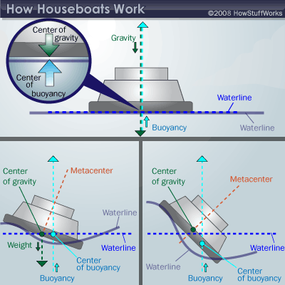Keeping a Houseboat Afloat
The most important matter of traveling on a boat is, of course, staying afloat. Tipping over or sinking puts us in danger of drowning, and it's even more important for a houseboat owner because that boat is home. Fortunately, all types of boats are designed to keep that from happening. But how does a boat stay afloat, much less an entire home?
The key principle that keeps boats floating is what's called buoyancy. If you pushed down on a boat while it was in the water, it would sink a little bit. Once you stopped pushing, however, the boat would bounce back up a little, almost as if something lifted it, before it settled back into the water again. In fact, the water is actually pushing up against the boat, just as the boat is exerting a force downward.
Advertisement
When the pressure of a body of water is equal to the weight of an object, that object will remain buoyant and float on the water. If the object is too heavy or dense, it will sink below the waterline. People typically build houseboats out of either fiberglass or wood, because they're light and will float easily.
That's how a boat stays afloat, but the way in which it stays upright is a different matter. Of course, unlike the land, you have to account for waves in the water, which will move a boat around significantly.
A boat has two centers: a center of gravity and a center of buoyancy. The center of gravity is the force that pulls the boat down toward the water, while the center of buoyancy is the force that pushes back on the boat. A regular sailboat has a center of gravity that's lower than its center of buoyancy, which helps keep the boat upright. That may not be the case in a houseboat, which may rest upon a raft -- the center of gravity is therefore higher than the center of buoyancy.

If the boat tips to the right, its center of buoyancy shifts to the right also -- the water is pushing up on the boat's right side instead of its middle. It's almost as if the water is trying to lift the boat out of the water, and the farther out the water pushes, the more likely it seems the boat will tip.
As you can see in the diagram, the center of gravity and the center of buoyancy intersect at what's called the metacenter. The lower that intersection is, the closer the boat is to tipping over. Once the metacenter points below its center of gravity, the boat will tip over. Fortunately, this only happens in the case of extreme weather, where large waves can be produced by strong winds that could easily tip over a houseboat -- you wouldn't find marinas located in areas that experience such weather.
Another force, called the righting moment, also keeps a houseboat upright by forcing its weight down. You can even express the righting moment mathematically -- it's simply the weight of the center of gravity times the distance between the two centers. If a boat weighing 15,000 pounds shifted its center of buoyancy out three feet, the force applied by the righting moment would be 45,000 pounds per foot, an impressive amount of power. The farther away the center of buoyancy swings from the center of gravity, the harder the righting moment works.
To learn about houseboat maintenance and the rules and regulations you can expect aboard one, see the next page.
